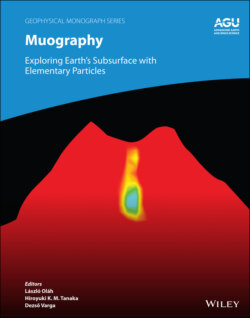Читать книгу Muography - Группа авторов - Страница 30
1.3.4 Plate Tectonics and Volcanism
ОглавлениеMuography has been also applied to studying the tectonic history of the Earth by revealing the subterranean bulk density distribution averaged over the hectokilometric‐scale area. By installing the detectors inside the multiple tunnels, which are randomly but uniformly distributed over this area, the density distribution above these tunnels can be measured. Tanaka (2015) conducted tunnel muography to the southern part of Izu peninsula, the tectonically active peninsula that was made by collision with Honshu Island, Japan, about one million years ago. The formation history of Izu peninsula will be summarized below.
Approximately 20 million years ago, submarine volcanoes were active on the Philippine Plate. The Pacific Plate was submerged underneath the Philippine Plate, and drove this submarine volcanism by supplying magma from underneath the Philippine Plate. These submarine volcanoes gradually grew and became volcanic islands ~2 million years ago. These islands have further grown and merged to one large island and finally collided with the Japanese main island called Honshu ~1 million years ago, and formed Izu peninsula (Koyama & Umino, 1991). Even after this collision, the active volcanism continued on Izu peninsula until ~200 thousand years ago. Volcanoes had repeatedly erupted and consequently covered the surface of this peninsula with basaltic rock.
Tanaka (2015) mapped out the shallow subterranean bulk density distribution of an area of 1,340 km2 by measuring the density of the rock overburden of 146 tunnels, and compared the averaged density in Izu peninsula (2.26 ± 0.03 g/cm3) with those in the nearest (Miura Peninsula) (2.55 ± 0.03 g/cm3) and next nearest neighbor (Boso Peninsula) (2.50 ± 0.02 g/cm3) peninsulas (Fig. 1.7). All of these values include the low‐density regions located underneath the seismic fault segments. When the data from these low‐density regions were excluded, they were respectively 2.52 ± 0.05 g/cm3, 2.60 ± 0.03 g/cm3, and 2.59 ± 0.02 g/cm3. Above density variations reflect the tectonic difference between Izu and other peninsulas. Geologies of Miura and Boso peninsulas are essentially uplifted accretionary prisms that both originated from the sediments deposited on the Pacific Ocean floor (Yamamoto, 2006). Volcanic rock is generally more porous, and thus its bulk density is lower than the surrounding sedimentary rock.
Figure 1.7 Density variations of the central southern region of Honshu, Japan. The densities plotted in this map were derived by excluding the data from the low‐density regions located underneath the seismic fault segments. (a) The map of Japan along with an indication of four tectonic plates. The dashed lines indicate the interface of these tectonic plates. (b) The enlarged map showing the geographical configuration of Izu, Miura and Boso peninsulas. (c) The muographically surveyed area in Miura and Boso Peninsula. (d) The muographically surveyed area in Izu Peninsula. (e) Geological maps of the Miura peninsula, indicating the distribution of the accretionary complex formed (1) between 40 and 20 million years ago; (2) marine and non‐marine sediments formed between 15 and 7 million years ago; (3) those formed between 7 and 1.7 million years ago; (4) those formed between 1.7 and 0.7 million years ago; and (5) those formed between 0.7 and 0.15 million years ago. Black dots show the locations of observation points. (f) Muographic image of the subterranean density distribution of Miura peninsula. The colors in this map indicate the terrain density. The region used for plotting this figure is shown by the inset in (e). Two blue dashed lines respectively indicate Kinugasa and Kitatake active fault segments.
The density variations between the submarine volcano‐originated peninsula and accretionary prisms‐originated peninsulas could also be found in the results of the gravimetric measurements, which compared Izu peninsula (2.2–2.3 g/cm3) with Kii peninsula (2.5–2.7 g/cm3) (Nawa et al., 1997). The gravimetric density of Izu peninsula is in agreement with the muographic density before excluding fault segments. While gravimetric measurements provide geologically meaningful subterranean bulk density information, the derived density values are strongly affected by local topography and geology. In particular, sharp offsets generated by faults in Bouguer anomaly result in erroneous and unreasonably high or low density (Nawa et al., 1997).
As a consequence, Tanaka et al. (2015) derived bulk densities for different rock types: (i) accretionary complex formed between 40 and 20 million years ago (2.79 ± 0.05 g/cm3); (ii) marine and non‐marine sediments formed between 15 and 1.7 million years ago (2.57 ± 0.03 g/cm3); (iii) marine and non‐marine sediments formed between 1.7 and 0.7 million years ago (2.43 ± 0.05 g/cm3); and (iv) basaltic and andesitic rock formed between 7 and 1.7 million years ago (2.51 ± 0.05 g/cm3). These muographic values were consistent with the gravimetric values of 2.63 ± 0.09 g/cm3, 2.54 ± 0.15 g/cm3, and 2.58 ± 0.2 g/cm3, respectively, for Mesozoic, Tertiary, and Quaternary sedimentary rocks, and 2.53 ± 0.15 g/cm3 for Tertiary volcanic rock (Nawa et al., 1997).
